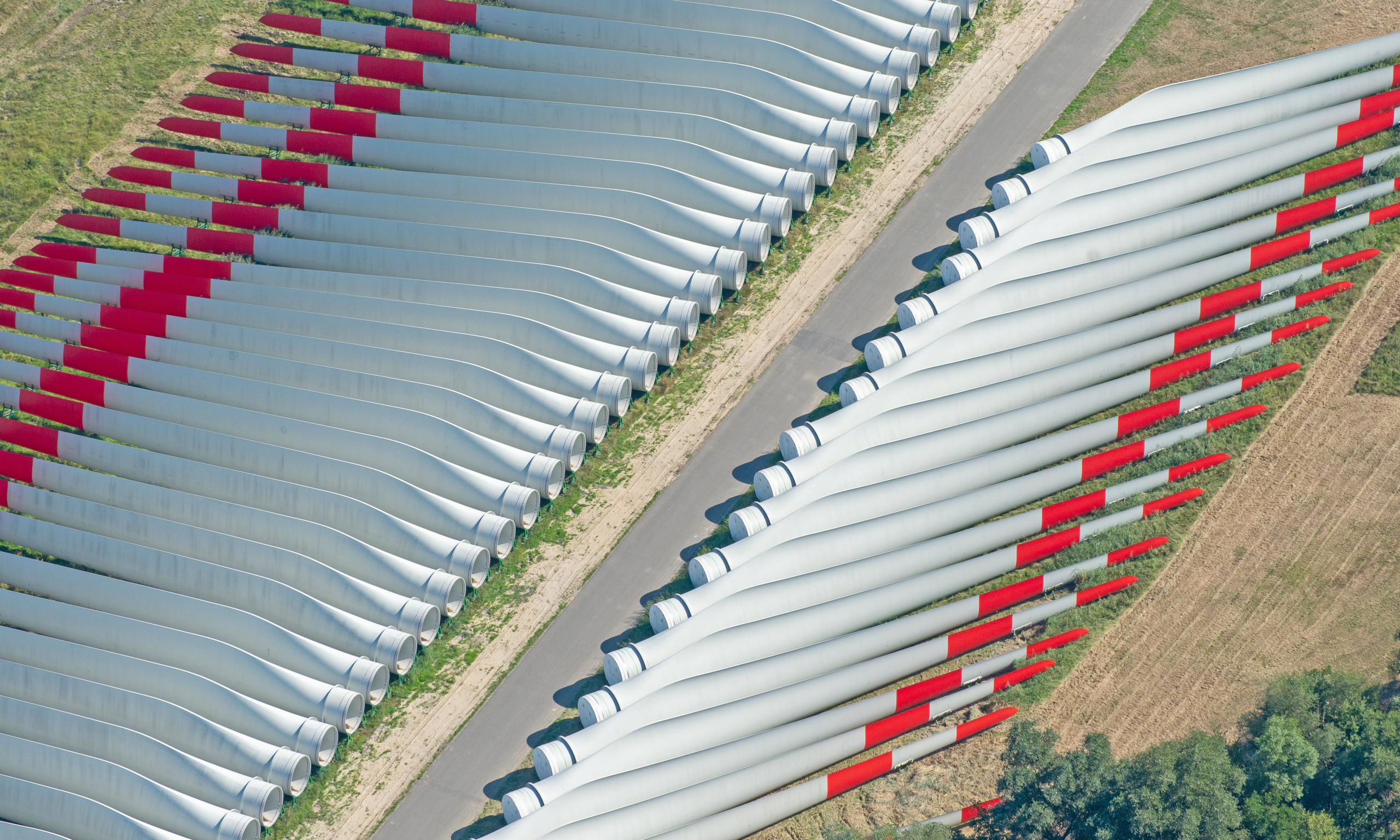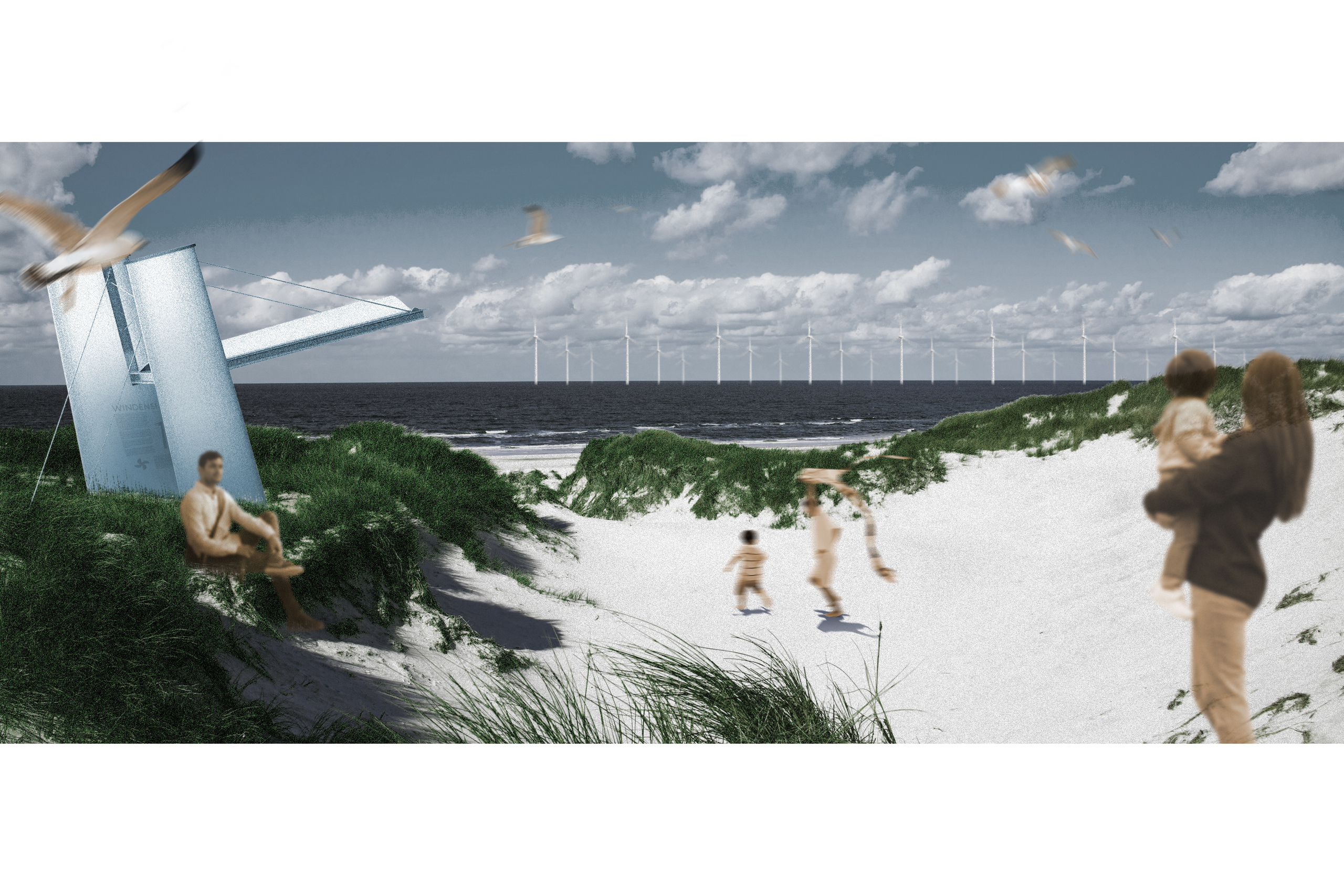Wind power has a waste problem

In Germany, first-generation wind turbines are gradually getting on in years, old rotor blades display signs of damage, are no longer efficient enough, are replaced and end up... well, where? Today’s rotor blades are up to 80 metres long. According to estimates, in future around 7,500 of them will be taken out of service each year. Shredding them is extremely complex, as is transporting them. This has led an interdisciplinary team of teaching staff and students at Darmstadt University of Applied Sciences to think in a completely new direction: old rotor blades should become building materials. To begin with, there are no limits to the imagination.
By Christina Janssen, 27.6.2022
You have to look a little closer to recognise what this stadium roof is all about: the beams of the roof construction... don’t they remind you of something...? In the 2021/22 winter semester, bachelor’s students Lukas Bressler and Christian Lovric came up with the design for the Wormatia Stadium in Worms: the support structure for the roof consists of rotor blades 32 metres long. With this, the two students have done justice in a quite spectacular way to the task assigned to them by architecture professor Marcin Orawiec and contract lecturer Jasmina Herrmann: “Here’s a rotor blade. Make something from it.” And do it in such a way that you use the largest possible pieces.

At the moment, it’s all still just an idea on paper: architecture student Bressler and aspiring environmental engineer Lovric have developed their design with the aid of a digital model of a rotor blade. With a length of 32 metres, their rotor blade is today already a kind of miniature example: 70 to 80 metres are meanwhile the standard. That is considerably higher than h_da’s University Tower (66 metres); two of them would produce a rotor diameter the height of Cologne Cathedral (157 metres). That is another reason why no real rotor blade has yet landed on h_da’s campus. None of the university’s buildings is big enough to just dump a load of rotor blades in it, as if a horde of Cyclopes had gathered to play pick-up sticks. Alternatives are currently being sought.
“Classical recycling is not a solution”
In the winter semester, Professor Orawiec and Jasmina Herrmann supervised the first course on “New Life for Rotor Blades” at the Faculty of Architecture. A “not quite everyday topic for us either”, says Orawiec with a little smile, hinting to the fact that an architect’s creative imagination knows no limits. Something which is not ruled out for engineers either: the idea of including rotor blade recycling as a topic in teaching and research came from mechanical engineer Professor Andreas Büter from the Faculty of Mechanical and Plastics Engineering at h_da. Until 2020, he was in charge of the Fraunhofer Alliance for Lightweight Engineering. Büter is thus a noted specialist for everything that needs to be extremely light and nevertheless extremely stable – aircraft wings, for example, or – like here – rotor blades for wind turbines.
In Orawiec and Herrmann, Büter has found the perfect partners for his project: both are dealing with “urban mining”, a sustainability topic that centres on the question of how to reuse construction materials from demolished buildings in order to save resources. In addition, environmental engineer Professor Iris Steinberg (whose specialisation is circular economy) and civil engineer Dr Markus Schmidt, an expert in building materials science, are complementing the team with their expertise. The group is supported by the Fraunhofer Institute for Wind Energy Systems (IWES).

With 7,500 rotor blades taken out of service each year, an unimaginable amount of material is accumulating in Germany alone that must somehow be reused. “Wind turbine operators want this too and have approached us about it,” reports Andreas Büter. Those now thinking of recycling in the conventional sense – shredding, melting down, remixing – have only the second-best solution in mind: the outer layer of a rotor blade is composed of complex plastics reinforced with glass or carbon fibres. “Shredding destroys these long fibres, meaning that the material could then only be used as an inferior admixture,” Büter explains.
There are no alternatives to plastic
It would be classic “downcycling”, and also highly complex because a rotor blade cannot simply be cut up like that. “The material is brittle, abrasive and blunts normal tools immediately,” says Büter. “We once tried to saw a rotor blade into pieces at the Fraunhofer Institute ourselves. In the end, a gravestone mason had to come and do it with his professional equipment.” When sawed, dust is produced that is hazardous to health and – if carbon fibres are mixed in – electrically conductive. “If it settles in the machine, it breaks down straight away.” In a nutshell: difficult to build, difficult to destroy.
Nevertheless, one thing is clear: there are no alternatives to our “beloved” plastic (FRP or CFRP). “We’ve also tested other materials for wind turbines at the Fraunhofer Institute, for example natural fibre reinforced plastics,” reports Büter. “But performance is inadequate, the demands on such an 80-metre-long rotor blade in terms of rigidity and stability are enormous. It can’t be done without carbon fibres.” Not to speak of aluminium and steel, which, according to Büter, are far too heavy.
The rotor blade group’s guiding principle is therefore: the less sawing, the better. “Making pieces of furniture from the rotor blades was therefore not an option,” says Jasmina Herrmann. Think big. The stadium roof clearly fulfilled this criterion. “But it was also important for us to develop something that could potentially go into series production,” says Herrmann. “After all, more and more rotor blades are going to accumulate.” This could work with the small information pavilion that Niklas Murmann, architecture student, and Leon Liebeskind, environmental engineering student, have designed. It consists of a rotor blade dismantled into five parts.
“Coming up with a good idea proved difficult. We were absolutely free as far as the design was concerned, so it could have been anything from a garden wall to a skyscraper,” says Niklas Murmann, remembering the start of the semester. “We then decided to make this information pavilion, which you could set up on low hills, for example, or on the coast.” In other words, in those regions where wind turbines are predominantly in use.
In this way, old and new would be juxtaposed. Hikers or beachgoers could rest under the shady roof of the little rotor blade buildings and find out about the special features of the location, the region or alternative energy production. “For us, it’s also important to build a bridge in terms of content,” emphasises Liebeskind. “We want to create an understanding of where our prosperity actually comes from and that electricity out of the socket should not be taken for granted.”
From design to prototype ready for series production
Murmann and Liebeskind are a mismatched pair; each contributes his own slant on the subject. “We intentionally put together interdisciplinary teams of students,” says Jasmina Herrmann. And the learning effect soon materialised. “I learnt from Niklas how to handle such an unusual shape in the first place,” reports Leon Liebeskind. “A rotor blade is round at the base and shaped almost like a knife blade at the end. Niklas showed me how to visualise it in 3D and work with it. That helped a lot.” Uncharted territory for the environmental engineer and vice versa for architecture student Niklas Murmann: “For me, thinking so extensively about ecological balance was new: transport routes, for example, dispensing with concrete as far as possible or using materials that are available locally.” The two were supported by plastics and civil engineering students, who advised them on questions such as leaf construction or statics and in so doing introduced perspectives from other disciplines.
“Our student teams have presented some interesting solutions,” architecture professor Marcin Orawiec is pleased to say. “Still missing is proof that it also works in practice. We now have a tower, a stadium roof, a pavilion and a bridge. We’ll take these with us into the next semester as examples.” The designs will then be further developed in detail, models calculated exactly, joining methods and foundations examined more closely. “As soon as we have the funds and the space, we would like to turn this into a field trial.” The goal is to develop prototypes over the course of the coming semesters that could be offered to an industrial partner for production. “But we won’t manage that until we have something tangible to show.” In the meantime, a few more rotor blades will disappear from their lofty heights.
What works on a large scale can also work on a small scale
Despite all the enthusiasm, it’s clear to those involved that their idea alone will not solve wind power’s waste problem. “You won’t be able to process all the rotor blades with what we’re doing here,” says Professor Andreas Büter. Otherwise, you would have to clutter the whole of Germany with rotor blade constructions. The interdisciplinary project at Darmstadt University of Applied Sciences is therefore also about sending out a message: the construction industry as a whole will move – or be obliged to move – in the direction of sustainability and “circular thinking” in the coming years. Perhaps the rotor blade topic will provide a tailwind. After all, what’s possible with gigantic structures such as rotor blades ought to be easy with bricks, window frames or roof beams.
![[Translate to Englisch:] Architektonischer Entwurf des Info-Pavillons](/fileadmin/_processed_/4/6/csm_22_06_27_Rotorblaetter_Infostand_Entwurf_grau_947dc15fe7.png)

![[Translate to Englisch:] Blick in ein aufgeschnittenes Rotorblatt](/fileadmin/Bilder/Forschung/22_06_27_Rotorblatt_Querschnitt.jpg)
![[Translate to Englisch:] Statistik zur Größenentwicklung von Windkraftanlagen](/fileadmin/Bilder/Forschung/22_06_27__Grafik_Windradgroessen_Entwicklung.png)
![[Translate to Englisch:] Logo des Rotorblattprojekts in Schwarzweiß](/fileadmin/Bilder/Forschung/Logo_Rotor.jpg)